
Maverick Methods™: Workshop as Interactive-Mediated-Performance (WIMP) reimagined as Creative-Resistance-As-Political-Practice (CRAPP) with Multimedia Interventions And So Many Acronyms (MIASMA)
by Peta Murray and Stayci Taylor AKA The Jolly Good Fellows (JGFs)
- View Peta Murray's Biography
Peta Murray is a Melbourne-based writer, theatremaker and academic.
- View Stayci Taylor's Biography
Stayci Taylor is a Senior Lecturer at RMIT University, with a side hustle in cabaret and ukulele, teaching promiscuously across three programs in the School of Media and Communication.
Maverick Methods™: Workshop as Interactive-Mediated-Performance (WIMP) reimagined as Creative-Resistance-As-Political-Practice (CRAPP) with Multimedia Interventions And So Many Acronyms (MIASMA)
Peta Murray and Stayci Taylor AKA The Jolly Good Fellows (JGFs)
Introduction: Maverick Methods™
In the academy at large it is common to speak of the "genre" of things. Funding applications, promotion pitches, conferences, panels and dissertations all have generic modes that most of us are trained to understand, and to reproduce ad nauseam. Through our time as postgrads via ECR fellowships and into mid-career research we have, as the Jolly Good Fellows, left a trail of anti-generic interventions in our wake.
As we prepared ourselves for a first co-writing session on this piece, we dedicated almost an hour to a circuitous conversation about our lives in the academy at this cultural moment. We tried to put concrete terms to abstractions. We asked each other just what is a Practice Research Symposium and how might it offer an alternative path for a creative practitioner who would embark on the long journey down Dissertation Drive? We discussed the problem of the rubricisation of the assessment and feedback process and how it confines, obstructs, obscures. How does one put fractions to first scrivenings in creative, even artful forms such as screenwriting, or poetry, or creative nonfiction? We discussed the pressures of time against which we are measured; the ridiculous work management allocations and metricisations that tell us we may allow no more than 12 minutes per student per 850 words. And through all of this we spoke, without irony, in language peppered with acronyms. We discussed RAV1s and AWAM2s, DECRA3s and NTRO4s.
Our conversation, but more than this, our mirth, is the first site of resistance-by-banter we will explore in the space of this endeavour: reflection by way of reverse engineering an Instruction Manual for a workshop already delivered. Levity, play, meaningful irreverence, lears and taughter have become primary currencies of exchange between us since we (re-)met as HDR-students over ten years ago. The energetics of shared senses of humour and an ongoing and seemingly inexhaustible compulsion to make each other LOL fuel the assorted collaborative research projects we conduct both as Jolly Good Fellows and as world leaders in the emergent field of #diarology as founding co-members of the Symphony of Awkward.
Core to all these inquiries is our commitment to Maverick Methods™. These proliferate and shapeshift, finding multiple, mutable modes (MMM) of expression including an appetite for uber-acronymisation. Neologisms and pun-ful wordplay have delivered us toward votive pledges and acts of endurance that inevitably, if only through their sheer repetition and excess, become comical. At least, to us. Tropes, tools and techniques (TTT) from respective backgrounds in improvisatory performance, street theatre, stand-up comedy and live art have delivered us to DiaryBingoKaraoke (DBK)5, and to unpanellings that may be interpolated, shock value and all, into conference settings. Gamification, randomisation, sound effects and instruments, toys, dress-ups, illuminated batons, adhesive moustaches and customised sashes have all been deployed for their strategic value in academic settings as modus operandi for cutting through the "pompom circumstance" (Murray and Rendle-Short 2021, n.p.) while piercing any remaining bubbles of importance that may self-inflate alongside the cultivation of scholarly expertise.
Undercuttings, piercings and other pointy offerings let out hot air. Such methods, we contend, deliver fenestrations that cause collapse and a release of gaseous-ness as grandiosity (GAG). Maverick Methods™ call upon the mechanics of deflation, and with them, the release and blowing off of steam, a disciplinary de-flatus, if you will. Such playful indecorum signals a refusal to maintain boundaries between being in the know and being on the (k)nose while creating "the potential for the emergence of the new, not in frontal assault against structure but at the edges and in its pores" (Manning and Massumi 2014, 99). Such subsidence affords, paradoxically, spaces of resistance-in-the-ruins.
As we moved away from resistance-as-banter and into resistance-as-antithesis, we decided that this piece must take the form of an "instruction manual". Herein we may codify the rules of engagement, outlining key terminologies, tools, techniques, and prescribing means for the establishment and holding of safe spaces wherein "play and its accelerant—fun—create possibilities for moving away from the fixed conventions of the predictable" (Murray, Sempert and Taylor 2018, n.p.). Said Manual will be informed by the Maverick Methods™ we have deployed before in settings such as public online fora, conference panels and academic publications. It will be multi-media, comprising text, PowerPoint, obligatory dance breaks and some incidental community singing. It will also serve as a first attempt to document aspects of the commitment to the "art of resistant life" (Caygill 2013, 173) that we claim to model within the academy.
Instruction Manual (Plus Office Stationery) Towards Enhanced Resistance (IMPOSTER)
Don't be intimidated by this heading and the genius of the acronym. We have been doing this for a long time. As with all best pedagogical practice, it will be unpacked (and, like the office stationery, repacked - or stolen) over the next few pages.
Methodological Framework
To engage with a maverick methodology is to fully embrace the IMPOSTER Syndrome that most scholars endure (or, as we later argue, have thrust upon them) when putting themselves and their work into the world. So prevalent is the syndrome that it warrants a hefty, edited collection (Addison, Breeze and Taylor 2022) featuring essays theorising upon the impact of the neoliberal university on the wellbeing of its cohorts and offering strategies for resistance through "IMP-loying radical s/elf-care" (Murray and Magner 2022, 552) as a first line of defence. We might consider it an act of resistance to acknowledge this pandemic, and to shine a light on conditions that contribute to its contagion. In order to put the "action" in this "act of resistance", you need to know the rules of the game.
To confidently instruct others in the art of Maverick Methods™ a series of complex methodological approaches must be understood and embodied. This may take years so for those who are time-poor with busywork, here is a quick step guide:
Creative-Resistance-As-Political-Practice (CRAPP)
Immersing oneself in conceptual CRAPP begins with the acknowledgment that Maverick Methods is more than just, say, shits and giggles. It involves exposure therapy (e.g., writing a phrase like "shits and giggles" into a journal article and leaving it there), a crash course in Weasel Speak™, Applied Gossip™ and collaborative think-tanking (see also Weasel Speak™) on activist strategies.
Multimedia Interventions And So Many Acronyms (MIASMA)
Contemporary pedagogy allows for multi-channel learning styles, reliance upon A.I, and wholesale forgetfulness. For all these reasons and others we can't recall at this time, knowledge-delivery must be compact, efficient, scalable and memorable. Multimedia interventions are FONTASTICALLY SPECTACULAR , and likely to sear themselves into participants' retinas and visual memories, while the manufacture and dispersal of acronyms offers affordances of time-saving precision, portability and the exclusivity that comes with being able to speak in code. MIASMA ensures the emanation of appropriate disciplinary discharge.
Workshop as Interactive-Mediated-Performance (WIMP)
The methods comprising WIMP involve embracing performative resistance and leading by example. For instance, instructors must enter the space wearing the garb of the institution (in our case, the academy). Instructors will, over time, develop a fluency in a new language (Weasel Speak) which will be used liberally as a desensitising strategy. Double-acts are encouraged, as are alter egos, gender-queering, props and organised chaos. Digital literacy is recommended, as it is from here one can develop truly horrific instructional aids.
What follows is the full instruction manual for mobilising in resistance to the institution's conventions and categorisations and creating spaces of interdisciplinary practice for new forms to arise. It is offered in the hope of aligning your participants' values with their KPIs in a spirit of "antidisciplinarity" that may lead to "unbounded forms of speculation and modes of thinking" (Halberstam 2011, 10). Emulation is recommended and we suggest that while this may well be optional, resistance is useless.
I.M.P.O.S.T.E.R.
Instruction Manual (Plus Office Stationery) Towards Enhanced Resistance
PREPARATION
It is no secret that OFFICE STATIONERY is one of the perks of the gig. The academy is full of nerds, and we were all the kids who enjoyed the beginning of a school year because of the lure of new stationery. Parents and caregivers became experts in the fine art of covering exercise books in clear or coloured adhesive. Woe betides the grown up who sent a stationery nerd into the trenches with a crease in their Contact™. Anecdotally we know that many academics are stationery hoarders. We also know of the hoarding of unused notebooks, whose beauty provokes prolonged performance anxiety for their owner, who then pokes their ideas into a Notes app instead. A happy by-product of Maverick Methods™ might be that many participants are also able to rid themselves of their mint condition stationery addiction, alongside their Imposter Syndrome and Conditioned Compliance.
In an increasingly digital world, it is becoming more difficult to justify prolonged and excessive use of stationery staples, but Maverick Methods™ demands them (along with dress-ups). In your Instructor's Toolkit you will need:
★ institutional garb
★ a roll of butchers' paper
★ multiple decks of Post-it™ notes in a variety of hues
★ permanent markers
★ scissors
★ glue or tape
★ magazines
★ document shreds salvaged from the photocopy bay
★ academic ephemera - for example, lengths of lanyard, letterhead, mascots
★ The Queer Art of Failure
ACTIVITY 1: ACTIVISM AUDIT
This is the introductory and contextual bit in which you and your co-facilitator(s) conduct workshoppees towards the belief arts-based activism is nothing to fear. Pin a badge reading "A Woman Needs a Man Like A Fish Needs a Bicycle" to your lapel, or recite some affirmations (I Play, Therefore I Am) as you remind attendees that most of them are already well-versed in artistic means of mischief-making as a form of protest or resistance in civic spaces (McIntyre 2013) or have encountered, without harm, playfully subversive approaches to activism, whether within the theatre of the public demonstration, the BUGA-ed-up billboard, or via media pranksters such as Pussy Riot.
For this reason, it is advisable to conduct an Activism Audit (AA) in the form of a quick and ice-breaking Never-Have-I-Ever (NHIE) activity in which you ask participants to self-identify against the following:
- Never have I ever worn a slogan or protest-branded t-shirt or another garment in public.
- Never have I ever defaced, graffitied or paraded anything unsavoury in civic space.
- Never have I ever displayed a sticker on a vehicle/device/other surface professing support for, or opposition to a cause.
- Never have I ever engaged in picket line hi-jinks, street theatre, or creative direct action.
- Never have I ever known the lyrics to all three stanzas of Blowing in the Wind.
Here you are trying to "read the room", as it were, for its risk-aversion or foolhardiness. Do not be surprised if the risk-o-meter points towards the former. In the academy, where seriousness is prized and scholarly heavyweights lauded, those viewed as being less than solemn, grave, earnest, grim and humourless may be regarded with suspicion and seen as flippant, frivolous, glib or somehow intellectually shallow.
Maverick-ly methodological approaches will be unfamiliar to many, yet they are accumulating in depth and richness in contemporary scholarship, arriving via an array of different portals including queer and critical autoethnography, creative practice research, and socially engaged arts6. Even so, expect scepticism, reluctance, and the withholding of eye contact.
Another icebreaker of some kind, such as a quick round of T.T.a.a.L. (Two Truths and a Lie) may be helpful here. Community singing is also encouraged, but sometimes best kept to the end.
If all else fails in what is intended to be the warm-up and forming-norming-storming and pre-performing stage of the workshop, a cover-to-cover reading aloud from The Queer Art of Failure may be deployed as a last resort. You may wish to keep a copy under glass.
ACTIVITY 2: LOL YOUR THESIS
The brainfart that delivered #lolmythesis is attributed to a scholar named Angela Frankel, who, in 2013, set up a blog site as a diversionary and procrastinatory tool to keep her from her own research within the field of Human Developmental and Regenerative Biology (lolmythesis, n.d., n.p.). Proclaiming it cathartic, while also acknowledging its value as a "living archive" (Hall 2001, Derrida and Prenowitz 1995) of the stress, hilarity, and chaos that dogs the typical researcher's life, Frankel's tag subsequently went viral, and continues to gather contributions some ten years on (at the time of writing).
As the abstract and PowerPoint for this workshop attested, an excess of wordage is a signature of the textual-as-parodic (TAP) in any maverick methodological endeavour, being an essential tool of the verbosity-meets-pomposity (VMP) ever-present in the academy. In order to deflate and release some of this grandiosity (AKA hot air) within the prolixity of the expansiveness of the discursiveness so customary in this space, a quick round of #lolmythesis serves not just as an efficient icebreaker, but an invitation to participants to distil their nerdish fascinations into something tweetably pithy, "summing up years of work in one sentence" (lolmythesis, n.d., n.p.).
Ergo, Dr Taylor's dissertation, formally/formerly titled: Funny/Peculiar: a creative practice approach to flipping perspectives for female protagonists in comedy becomes, when lol-ed:
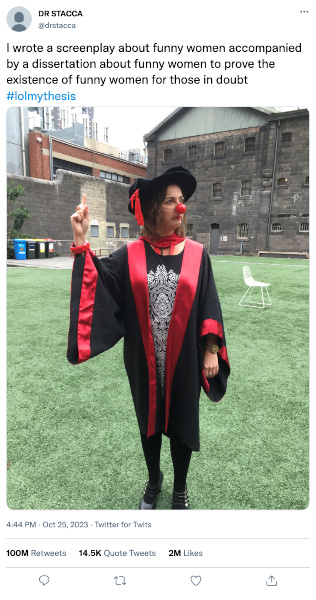
Dr Murray's cryptically titled Essayesque Dismemoir: w/rites of elder-flowering, also lol-ed and de-colon-ised becomes:
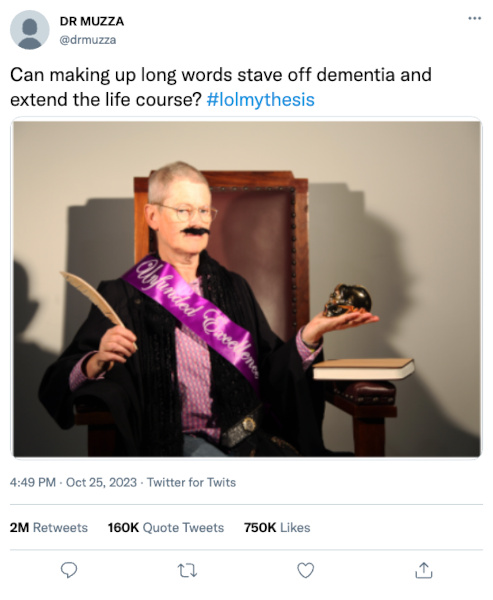
There is something deeply cathartic in this act. In reducing and diminishing something that is the fruit of years of labour into a micro-summation of a mere 280 characters or fewer the researcher is invited to perform a cathartic rite of purgation, allowing a kind of spiritual evacuation whereby the work may "pass" from the Bowels Of The Intellect (BOTI) into the ether of the digital void. There, now in shrunken form, an entire thesis may be shared efficiently with others as a kind of scholarly microdose—allowing users to benefit from its intent while sparing them any undesirable side effects.
ACTIVITY 3. ACRIMONIOUS ACRONYMITY
This section of the instruction manual is best presented via the medium of Bad PowerPoint™. In this way, we are leading by example in the spirit of Halberstam's exhortation that we must "First, resist Mastery" (2011, 11). To deliberately make an appalling slideshow can be difficult, as programs like PowerPoint™ evoke the same lure as fresh stationery; their digital affordances somewhat akin to the magnificent props and embellishments attached to the 1980s phenomenon of modern scrapbooking. It is inevitable that stationery nerds in the academy will find themselves operating in the spaces of PowerPoint™, Keynote™, Prezi™ and other presentation builders (most now with enhanced AI) and so a critical part of the resistance mission is putting the sideshow in your slideshow. Adhering too strongly to the rules of effective visual aiding is, after all, a slippery slide. As part of the aforementioned methodological approach we call MIASMA, within this video (extracted from the most recent workshop run by the Jolly Good Fellows at an unnamed institution) you will also be schooled in the art of Acrimonious Acronymity™ and shown how to send each participant home with their very own acronym!
ACTIVITY 4: IM-POSTERS FOR IMPACT (i4i)
"Feeling like an imposter isn't an illusion, it's the result of systemic bias and exclusion" write Ruchika Tulshian and Jodi-Ann Burey (2021), coining an un/intended rhyming couplet, and pointing out yet another way in which marginalised workers are gaslit into taking responsibility for the failures of the institution by lamenting their own ability to conjure up self-belief and positive self-messaging. Cue the rounds of assertiveness and leadership training for women, and any number of well-being workshops advising one should stop checking emails and learn to say no.
The research poster is one of the deliverables of our industry AKA the academy, another way of presenting our research at conferences and symposia, beyond the standard talk plus presentation. It is described on one institution's website as "a multi-modal communication genre" (University of South Australia n.d., n.p.). Despite this upbeat categorisation, it is a truth universally acknowledged that if a conference accepts your abstract for the "poster stream", you have been awarded the booby prize which is not as saucy as it sounds. As Wikipedia7 (n.d., n.p.) explains:
The word"boob" stems from the Spanish bobo meaning silly, which in turn came from the Latin balbus meaning stammering; the word booby to mean dunce appeared in 1599. Booby prize literally means"idiot's prize". The OED dates this usage to 1893. Booby trap and"booby hatch" are related terms.
In other words, if you find yourself in the poster stream, the conference organisers have rolled their eyes at your submitted abstract and declared you a dumb-dumb. Or have they? In a piece titled "Combatting Poster Fatigue", the authors acknowledge that "it is assumed that a paper accepted for oral presentation is worthier than poster presentation" but insist that this is "not true" (Faridi, Narang and Ali 2006, 372). They make a spirited argument for the value of the poster but advise: "Unlike oral presentations where some ultra-smooth speakers attempt to divert the attention from a poorly planned presentation; with posters, poor planning is visible to all" (Ibid.) Among their advice is that "even the figure legends should be visible from a distance of 4 feet1.2 metres" (Ibid.), and we advise adding a retractable tape measure to your toolkit, as we shall when we next circle back to roll out this workshop.
This activity uses the format of the research poster and is designed to uncover your participants' perceived inadequacies as a triumph of show and tell. We consider it a capstone of the workshop; in that it repeats the acronym of the workshop itself AND makes good on that stationery cupboard raid. In its first outing, it also earned a High Distinction in the queer art of failure by running over time by around 516% and decimating the rest of the syllabus.
Step 1:
Before the workshop, display your collected research posters on the wall and, when it comes time for i4i, invite participants to peruse the "exhibition" noting how these exemplars combine "text with graphics, colour, as well as speech and interaction with audience, to convey meaning" (University of South Australia, n.d., n.p.). These will serve as inspiration for the task at hand.
Step 2:
As with all tasks (and as demonstrated by the Acrimonious Acronymity™ activity shared via the medium of Bad PowerPoint™ above), we recommend developing a template for each module. For example:
| Activity: i4i ➔ Task: Make a research poster presenting your perceived im-poster ➔ Effort level: Be prepared to fail ➔ Mode: Crafternoon ➔ Time: 15 minutes |
|---|
Step 3:
Create.
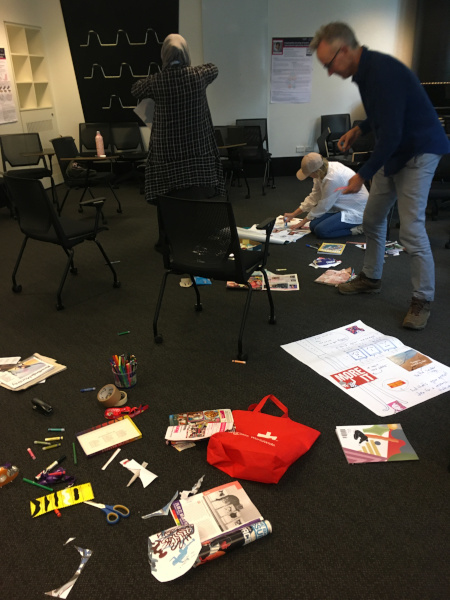
Step 4:
Display.
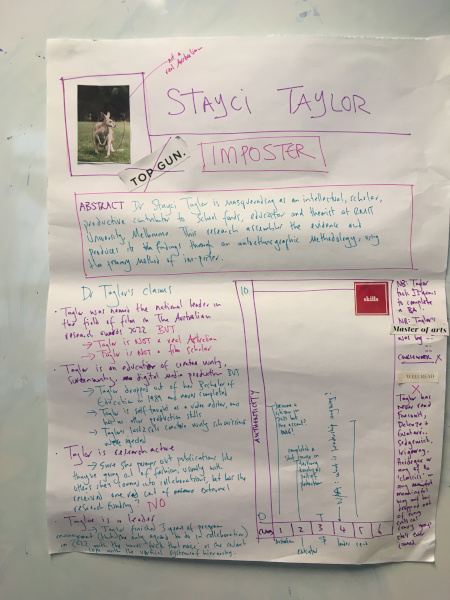
Step 5:
Gallery tour and artist statements.
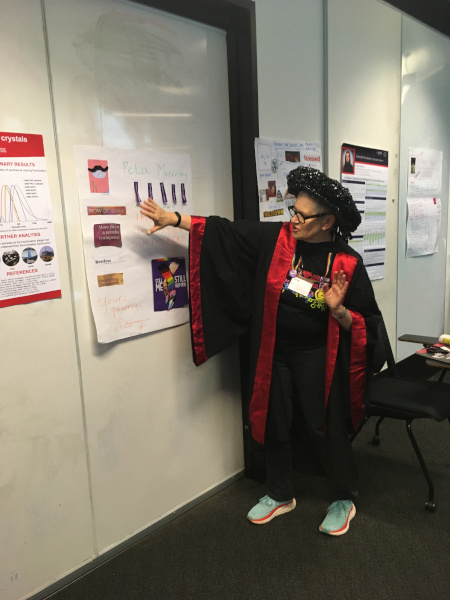
These are but four of the activities that can be undertaken in a Maverick Methods™ workshop. We look forward to hearing of your adventures, adaptations and additions at maverickmethodologies@gmail.com.
Conclusion
James Byrne writes of the need for remedies to "vertigoes within hierarchical space. To write against being up there" (2022, 151). Indeed, there is something vertiginous about the academy, something that while it may not induce nosebleed, is capable nevertheless of destabilising and causing a dangerous loss of balance. This sensation, if suffered alone and in private, can distort and cause disequilibria of all kinds - in the ratio between one's life and work, in an overload of gravitas and self-importance, and in subtle yet damaging ways in which we sideline our own needs, and those of others, in the name of the ascent to headier and headier heights. It is not surprising then, that many of us plummet into pits of burnout, depression, anxiety and general malaise.
Acts of resistance, in the hands of the JGFs, become enactments of resistance, allowing us to "lol" our creative practice before witnesses through the performance of small but meaningful gestures of civil disobedience. Mild-mannered mockery and riotous ridicule may appear to be entry level subversive measures designed to bring things down to size. Even so, when these shrinkages are performed in the presence of others, they restore a sense of proportion, and with it, capacity to recover "the joy that can be found in the dance between trauma and laughter, between seriousness and light" (email commentary from workshop participant.) Resistance through such jollification, then, becomes a renewable, green energy, naturally replenishable on a human timescale and as a humane human resource.
Works cited
Addison, M., Breeze, M. and Taylor, Y. (eds.). (2022). The Palgrave Handbook of Imposter Syndrome in Higher Education, London: Palgrave Macmillan
Byrne, J. (2022). "Resistance". In Wardle, D, van Loon, J, Taylor, S, Rendle-Short, F, Murray, P and Carlin, D (eds), A-Z of Creative Writing Methods, London and New York: Bloomsbury, 150-152
Caygill, H. (2013). On Resistance: A Philosophy of Defiance, London and New York: Bloomsbury
Derrida, J. and Prenowitz, E. (1995). "Archive Fever: A Freudian Impression", Diacritics, 25, 9-63
Faridi, M.M.A., Narang, M. and Ali, M. (2006). "Combating poster fatigue", The Indian Journal of Paediatrics 73, 372
Halberstam, J. (2011). The Queer Art of Failure, Durham and London: Duke University Press
Hall, S. (2001). "Constituting an Archive", Third Text 15(54), 89-92
lolmythesis. (n.d.). "About lol my thesis", website, accessed 27 October 2023.
Manning, E. and Massumi, B. (2014). Thought in the Act: Passages in the Ecology of Experience, Minneapolis: University of Minnesota Press
McIntyre, I. (2013). How to Make Trouble and Influence People. Oakland: PM Press
Murray, P. and Rendle-Short, F. (2021). "Kin-as-ethics: experiments in un/authorised queer essay practice", Sydney Review of Books, 7 October, Accessed: 26 October 2023
Murray, P., Sempert, M. and Taylor, S. (2017). "Panel Play in Three Acts." Axon: Creative Explorations 7(1), April, Accessed: 26 October 2023
Murray, P. and Magner, B. (2022). "Putting the Imp into Imposter Syndrome". In Addison, M., Breeze, M. and Taylor, Y. (eds.), The Palgrave Handbook of Imposter Syndrome in Higher Education, London: Palgrave Macmillan, 545-562
Tulshyan, R., and Burey, J. (2021). "Stop Telling Women They Have Imposter Syndrome", Harvard Business Review, 11 February, Accessed: 26 October 2023
University of South Australia. (n.d.). "How to make a great research poster!", website, accessed 23 October 2023.
Wikipedia. (n.d). "Booby Prize", website, accessed 26 October 2023.
Footnotes
- Research Allocation Variation (above the baseline of 20% at our institution) ↩
- Academic Workload Allocation Model ↩
- Discovery Early Career Researcher Award (an Australia Research Council [ARC] grant) ↩
- Non-traditional Research Output. You're reading one. ↩
- A performance format for live diary readings, in the spirit of events like Mortified and Salon of Shame, but with less emphasis on comedy cringe and more on ceremony, randomising interventions and gamification. ↩
- See, for example, the participatory art of Ceri Hann, the autoethnographically-inflected spoken word of Denise Chapman, the queer performance futurity of Dr Duckie and the science-as-stand-up research translation of Bright Club. ↩
- Brazen use of the free-online encyclopaedia Wikipedia is itself a Maverick Method™. As the article "Wikipedia" on Wikipedia reminds us, Wikipedia is "the largest and most-read reference work in history, and has consistently been one of the 10 most popular websites", and therefore its utility cannot be overstated. It should be noted, however, that the one citation in the "Booby Prize" article leads to a broken link. ↩

